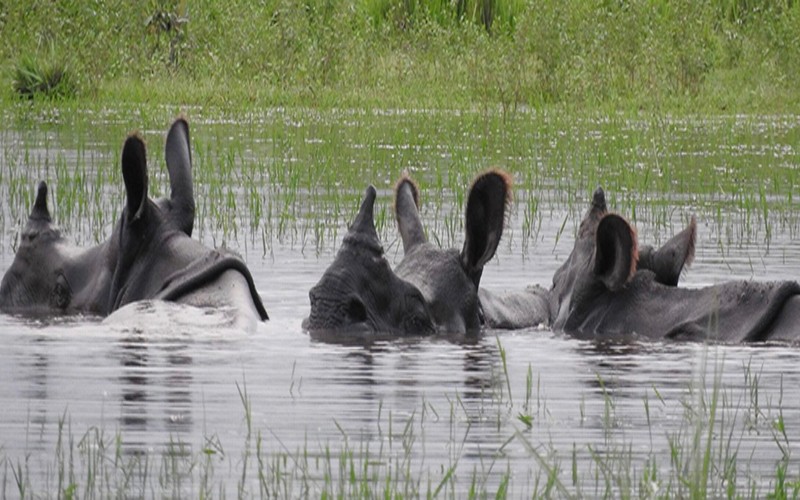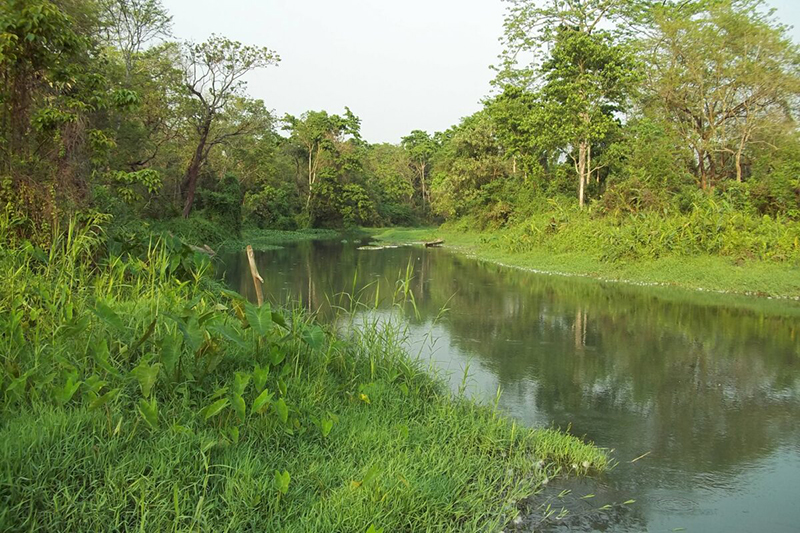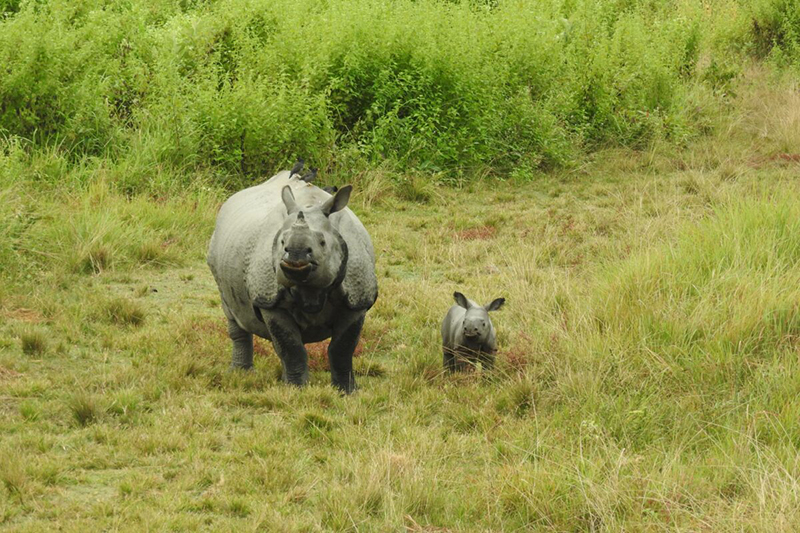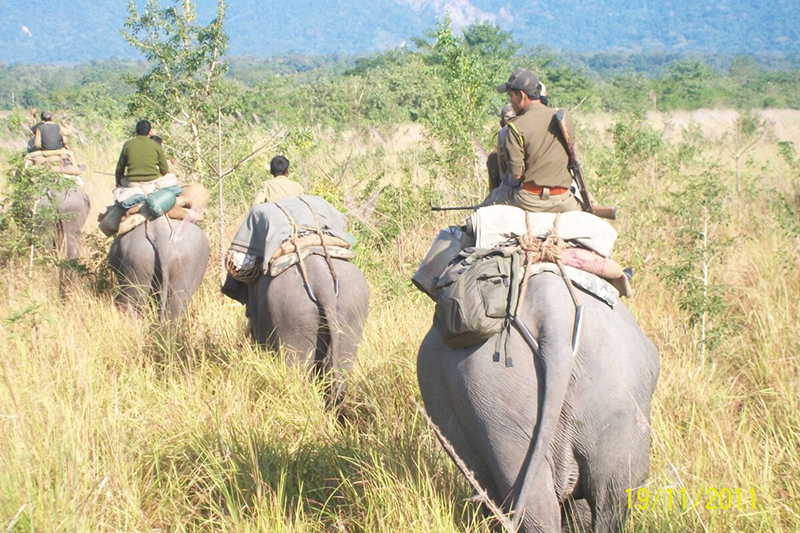
The new Rhino colony
India’s alarmingly low greater one-horned rhino population prompted the government to announce a conservation programme in 2005. Eighteen sub-adult rhinos were translocated from Kaziranga National Park and Pobitora Wildlife Sanctuary to Manas National Park in 2008 to revive the population there. A new study calls the translocation project a success and puts forward recommendations to ensure the future survival of the newly established rhino population at Manas. Mongabay India correspondent Arathi Menon reports
A review of India’s 15-year rhino reintroduction programme in Assam finds that rhinos that were translocated in the state were able to adapt effectively to their new environment. It highlights the potential of well-managed wild-to-wild translocation schemes to contribute to the recovery of endangered rhinos.
By the early 2000s, the rhino population in Assam was decimated, primarily by poaching. In an attempt to reverse this situation, the state government and Bodoland Territorial Council, with support from the International Rhino Foundation (IRF), World Wide Fund for Nature (WWF) and the United States Fish and Wildlife Service (USFWS), launched a programme, the Indian Rhino Vision 2020 (IRV-2020), in 2005.
The target was to take the population to 3000 rhinos by 2020 through increased protection of the existing population in Assam and relocating rhinos to protected areas (PAs) which they previously inhabited. Manas national park bordering Bhutan was one such protected area where a total of 18 rhinos — eight from Kaziranga national park and 10 from Pobitora wildlife sanctuary — were translocated.
A recent study by WWF India looks into the outcome of the translocation effort and the status and behaviour of the translocated rhinos.
Since 1928, when Manas national park, a UNESCO world heritage site, was declared a sanctuary, the park and its inhabitants have witnessed various changes and upheavals. In 1990, it was designated as a national park, covering an area of 360 km2. In 2016, an additional 350 km2 of the Manas Reserve Forest was incorporated into the park for rhino range expansion.
Historically, rhinos were hunted for trophies and later poached for their horns. Socio-political unrest between indigenous people and other communities, as well as army operations to contain the clashes, kept the region in perpetual strife. All these factors led to the local extermination of Manas’ rhinos, which were believed to number around 100 prior to these events.
 A perennial water source in the Panbari range of Manas named Lafasari. Ample water sources and verdant grasslands, along with other features, make Manas an ideal habitat for rhinos. Photo by Deba Kumar Datta/WWF.
A perennial water source in the Panbari range of Manas named Lafasari. Ample water sources and verdant grasslands, along with other features, make Manas an ideal habitat for rhinos. Photo by Deba Kumar Datta/WWF.
Ideal habitat for one-horned rhinos
With its alluvial grasslands, semi-evergreen forest and moist and dry deciduous forests, as well as elevation ranging approximately between 50 and 250 metres above mean sea level (AMSL), with the Manas-Beki river system providing a constant source of water, Manas national park is considered an ideal rhino habitat.
Deba Kumar Datta of WWF India, who is part of the project, says that the translocation was a success. It not only bolstered rhino numbers in Manas but also contributed to the development of the national park through initiatives such as establishing anti-poaching camps, infrastructure development and habitat protection. He highlights the improvement in the relationship between local communities with the park as well as the rhinos.
“An institutional approach was adopted for the translocation. Before the project, there were no facilities inside the park and even forest guards were hesitant to enter. However, things changed drastically after the initiation of this project,” he shares.
The global population of the greater one-horned rhino (Rhinoceros unicornis) in the family Rhinocerotidae stands at 4,023 (June 2022), of which 81.3% or 3,271 individuals reside in India’s national parks and wildlife sanctuaries. National lead of WWF in rhino conservation Amit Sharma shares that the existing population, however, has a very limited distribution. The six PAs where they are found are disconnected allowing limited chance of gene exchange, making them vulnerable to various environmental events.
The CEO of Guwahati-based NGO Aaranyak, Bibhab Kumar Talukdar who is the senior advisor of International Rhino Foundation for Asian rhinos and the chair of Asian Rhino Specialist Group of IUCN SSC says he believes that translocation was the best option for Manas since it is far from other rhino-bearing areas in Assam. “The natural dispersal of rhinos from other areas is not possible in Manas due to lack of connectivity and human settlements,” he says, adding that moving rhinos from Pobitora and Kaziranga was ideal.
According to Talukdar, the contiguous protected areas of Laokhwa and Burhachapori wildlife sanctuaries west of Kaziranga national park which lost all its rhinos during the socio-political unrest in the 1980s too are considered for rhino translocation under IRV-2020. Interestingly, however, the Assam government’s decision to add additional lands to Kaziranga, Burhachapori and Orang national park in the past few years along the river Brahmaputra, resulted in the protected areas getting reconnected, facilitating rhino movement between them.
“Since December 2023, at least two rhinos, which are believed to have come from Orang into Laokhowa and Burhachapori have been living in these two sanctuaries. There are possibilities that in coming months, more such rhinos will stray out and use the habitats of Laokhowa and Burhachapori as part of natural dispersal,” he explains. Sharma hopes that such remedial measures adopted by state governments as well as the Ministry of Environment, Forest and Climate Change (MOEFCC) would help tide over issues of isolation of rhino populations.
 A rhino with its newborn calf. Frequent courtship and mating among translocated rhinos were noticed, resulting in 38 calves, bringing the current population at Manas to 50. Photo by Deba Kumar Datta/WWF.
A rhino with its newborn calf. Frequent courtship and mating among translocated rhinos were noticed, resulting in 38 calves, bringing the current population at Manas to 50. Photo by Deba Kumar Datta/WWF.
Constant monitoring yields result
The study notes many positive outcomes of the project after monitoring 10 translocated rhinos through radio collaring over a five-year period from 2008 to 2013, starting with the first two rhinos R1 and R2 and gradually increasing the number of rhinos observed. Thirty-eight calves were born to translocated rhinos between 2011 and 2021. Datta says that most behaviours observed were similar to rhinos in the wild.
The researchers considered the initial 90-day period to be the acclimatisation phase, during which the rhinos attempted to adapt. Datta notes that in terms of home range, some differences were observed from their previous habitats. For example, Pobitora wildlife sanctuary has only 16 km2 of suitable habitat for rhinos. When they were relocated to Manas, their home ranges expanded to up to 268 km2, he adds.
The paper highlights distinct seasonal variations in activities, largely influenced by the availability of food and water. While maximum grazing activity was observed during the monsoon and retreating-monsoon seasons, rhinos were found to graze less during the winter season. Researchers attribute this mainly to the higher elevation and abundance of edible grass in Manas compared to flood-prone areas like Kaziranga and Pobitora. It also reports frequent courtship and mating among the rhinos, resulting in 38 calves, bringing the current population at Manas to 50.
 Forest guards patrol on elephants at Manas national park. The study says that rhino translocation help build Manas due to improved infrastructure, better anti-poaching efforts, etc. Photo by Deba Kumar Datta/WWF.
Forest guards patrol on elephants at Manas national park. The study says that rhino translocation help build Manas due to improved infrastructure, better anti-poaching efforts, etc. Photo by Deba Kumar Datta/WWF.
There’s hope in wild-to-wild translocation
The paper recommends several crucial steps to ensure the future survival and well-being of the newly established rhino population at Manas, including the implementation of genetic management plans to maintain genetic diversity and prevent inbreeding; sustainable habitat management practices to restore preferred rhino habitats; and the establishment of a robust disease surveillance system to guard against potential health threats.
Talukdar points out that in terms of protection for the species by reducing poaching, the Assam forest department, along with Assam police are doing very well through proactive vigil. He suggests that we need to give more emphasis on grassland and wetland habitat restoration which is crucial for the rhino population and to sustain the success of programmes such as IRV-2020.
“Habitat management needs top priority if we want to sustain the successes we have achieved in rhino conservation in Assam. Release of government funds to rhino areas on time is needed to enable managers to run the rhino bearing areas aptly,” he shares.
Expressing concern over the degradation of grasslands and wetlands in India significant for the rhino population, Sharma points to the RhoDIS India programme led by MoEFCC, which is building a DNA database to aid scientific management of the population and combat crimes against the species. Efforts are underway to promote sustainable tourism at the national park as a means of livelihood for the local community.
This is expected to empower local communities with a sense of pride and responsibility for rhino conservation. Datta emphasises the importance of transboundary cooperation between India and Bhutan for the long-term survival and health of the species. Sharma hopes for a Conservation Action Plan and special funding mechanism for rhino conservation, recognising the need for special attention to this species.
Support Our Journalism
We cannot do without you.. your contribution supports unbiased journalism
IBNS is not driven by any ism- not wokeism, not racism, not skewed secularism, not hyper right-wing or left liberal ideals, nor by any hardline religious beliefs or hyper nationalism. We want to serve you good old objective news, as they are. We do not judge or preach. We let people decide for themselves. We only try to present factual and well-sourced news.







